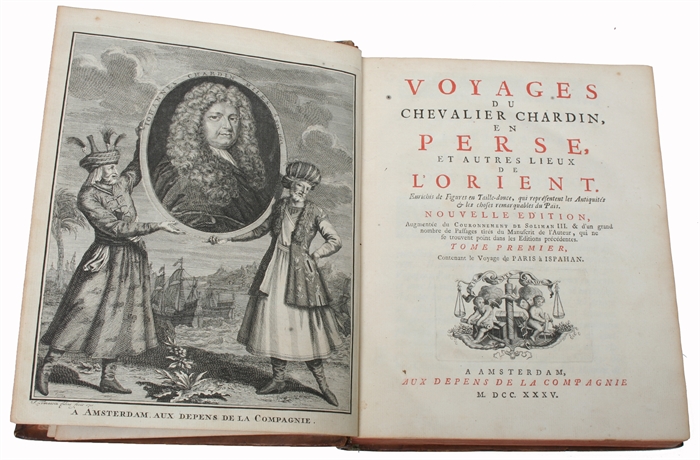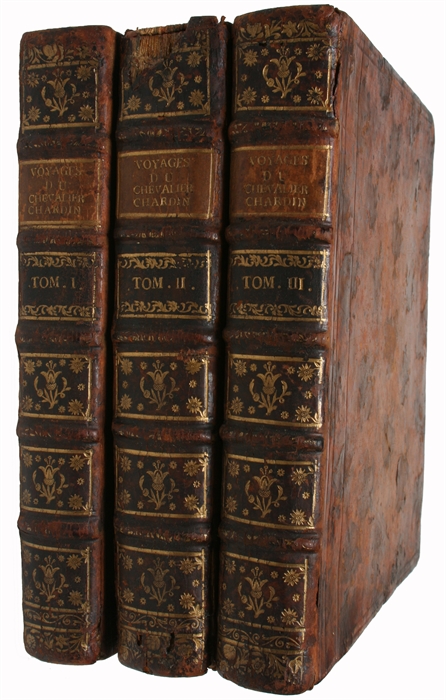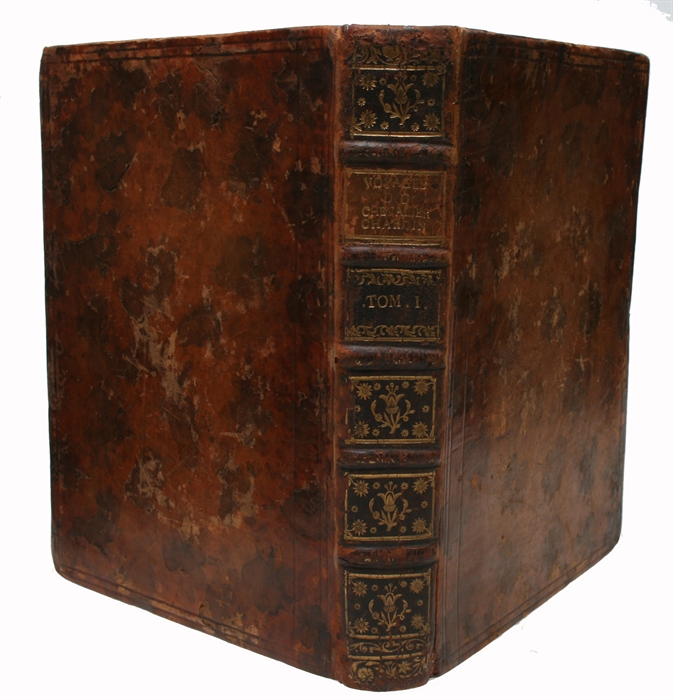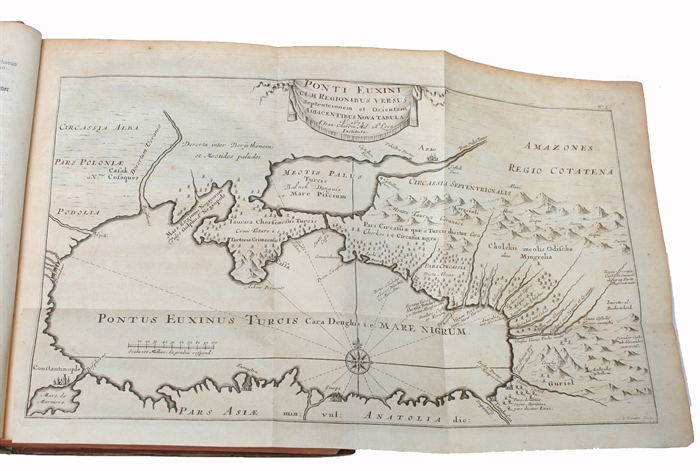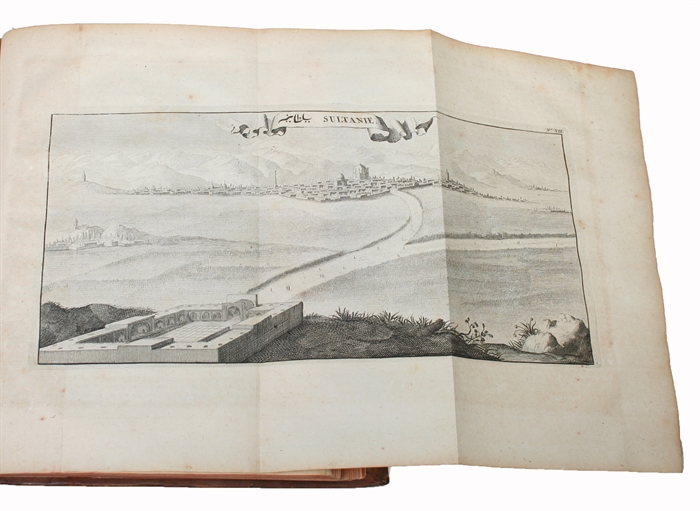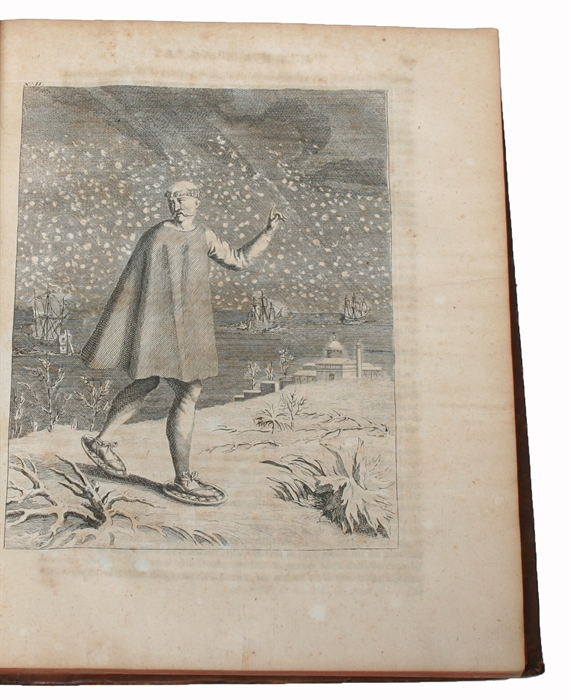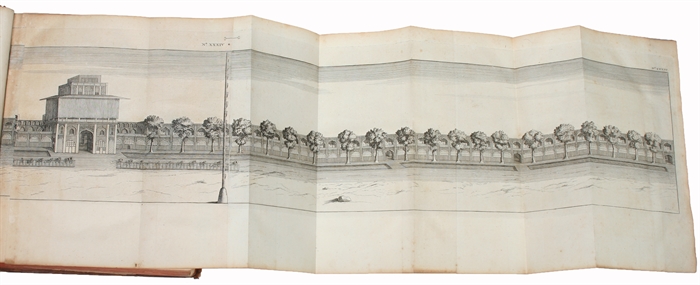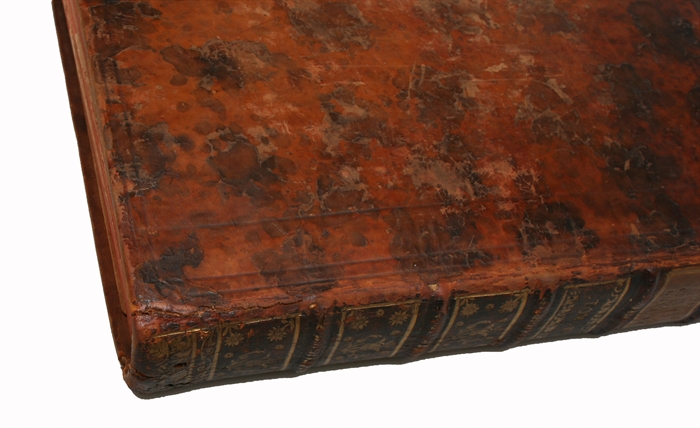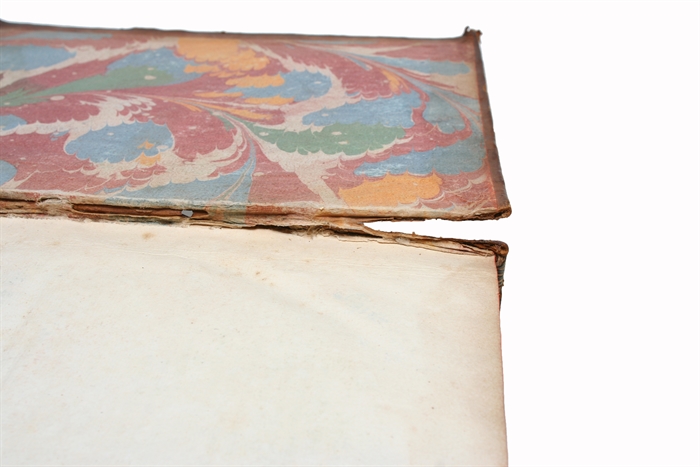CHARDIN, JOHN.
Voyages du Chevalier Chardin, en Perse, et autres Lieux de L'Orient. Enrichie de Figures en Taille-douce, qui représentent les Antiquités & les Choses remarquable du Païs. Nouvelle Edition. Vol. 1-3 (of 4 = "Supplement"). l. Paris á Ispahan - 2. d'Ispahan; & la Relation des deux Voyages de l'Auteur, d'Ispahan á Bander-Abassi. - 3....Description Générale de L'Empire de perse, & les Descriptions particulieres des Sciences & des Arts...Gouvernement Politique, Militaire, & Civil.
A Amsterdam, 1735.
4to. 3 cont.full mottled calf. Raised bands, richly gilt backs. Extremities with small traces of use, slight weakening to parts of hinge, top of spine on vol. II with loss of leather ca 1x2 cm. Internally fine on good paper. 2 engr.frontisp. (with portraits), 3 engr.titlevign., 3 large engr. textvignettes. (12),390,(4),359,(4),437 pp. and 78 mostly large folded engraved plates (maps,plans,views etc.). - To this second edition was published a 4th volume which contains the author's previously published work "Couronnement de Soliman III" and extracts from the author's manuscript, this supplementary volume is not present here, but the 3 volumes contain the whole travel and all the plates belonging to these 3 volumes.
Rare second edition of Chardin's travels, regarded as being one of the finest works of early Western scholarship on Persia and the Near East in general. "Thought to have been read by writers such as Montesquieu and Rousseau, Chardin's account stands apart from those of other travellers to the region (Caucasus) at this time through its awareness of cultural difference and relativity and in its desire to place accuracy above romanticism." (Speake, The Literature of Travel and Exploration, 1).
Chardin set out from Paris for Persia and India. He reached Ispahan 1673, spent four years in Persia, visited India and returned by the Good Hope in 1677. The first volume contains the trip from Paris to Isfahan, the second contains a particular description of Isfahan and the relation of the author's two voyages, from Ispahan to Bander-Abassi, the third contains a general description of the Persian empire and the particular descriptions of the sciences and arts which are in use therein, of political, military, and civil government.
Born in Paris in a Hugenot (Protestant) family, Jean Chardin (1643-1713) undertook his travels to Persia because of his father's position as a jeweler and shareholder in the French East India Company. The younger Chardin set out in 1664, traveling through Turkey, the Black Sea, Georgia and Armenia. Soon after his arrival in Persia, he received a commission to create jewelry for Shah Abbas II, who died in 1666 and was succeeded by Shah Safi. After witnessing the latter's coronation, Chardin went on India and finally returned to Paris in 1670. In 1671, he published an account of the coronation and in the same year set off for Persia again, arriving in Isfahan in 1673 and remaining there for several years, before once more visiting India and returning home in 1677. With the persecution of the Hugenots in France, he moved to England in 1680
"Travel restarted with 17th-century missionaries, whose medical and pedagogical expertise helped counterbalance Orthodox (or pagan) reservations. Dominican Prefects Dortelli D'Ascoli and Giovanni da Lucca (1630s) extended Giorgio Interiano's description of Circassia (and Abkhazia). Theatine proselytisers targeted Mingrelia/western Georgia (Capuchins the eastern provinces) - the Vatican's Fide Press further contributed by printing the first Georgian books (Chikobava/Vateishvili). Many, including mission-head Don Pietro Avitabile (1626-1638), recounted their experiences. Prefect to Mingrelia, Joseph Marie Zampi, a 23-year denizen from approximately 1645, contributed a third significant source in his description of Mingrelian religious practice. This he handed to Jean Chardin (1643-1713) in 1672. A French traveller who became English(!) ambassador in Holland, Chardin translated and incorporated it as a substantial part of his own description of a sometimes perilous journey through Transcaucasia (1672-3), which reflects Ottoman and Persian influence in western and eastern parts, respectively - a Turkish organized slave-trade flourished from various Mingrelian ports. Linguistically, Zampi revealingly observed that the ecclesiastical language, Georgian, was as difficult for even the Mingrelian priesthood to understand as Latin was for Italian peasants!" (Speake, The Literature of Travel and Exploration, 1, 199-202).
Brunet 1802
Graesse II, P. 121
Order-nr.: 7549

